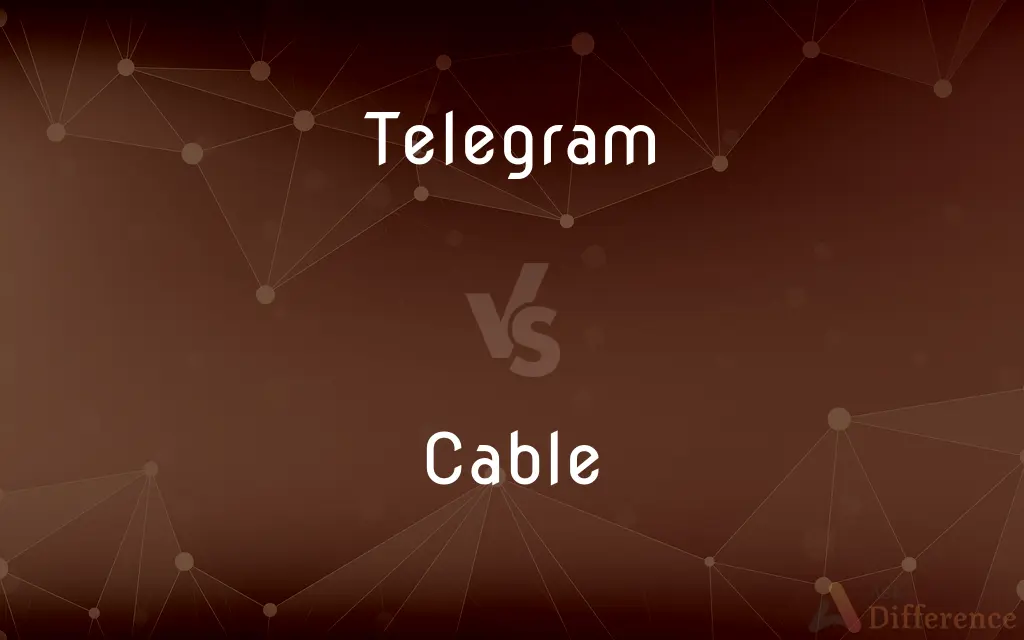Telegram vs. Cable — What's the Difference?
By Tayyaba Rehman & Maham Liaqat — Updated on April 18, 2024
Telegram is a digital messaging app known for its speed and security, enabling instant communication globally; cable refers to physical transmission mediums used in telecommunications and broadcasting.

Difference Between Telegram and Cable
Table of Contents
ADVERTISEMENT
Key Differences
Telegram is a modern messaging application that emphasizes speed and security, using cloud-based technology to facilitate real-time communication. On the other hand, cable, in the context of telecommunications, typically refers to physical conductors like coaxial or fiber-optic cables that transmit data and signals over distances.
Telegram allows users to send messages, photos, videos, and files of any type up to 2 GB each, supporting large-scale broadcasts via channels and groups. Whereas cable technology, particularly in broadcasting, is used to deliver television programming, internet services, and voice communications through a network of wired connections.
One of the key features of Telegram is its end-to-end encryption option in "secret chats," which ensures privacy and security for its users. In contrast, cable systems can be susceptible to interception and require various forms of signal encryption to secure data transmission.
Telegram operates on a global scale, with users able to access their accounts from any device connected to the internet, promoting seamless communication across borders. Cable services, however, are geographically limited by physical infrastructure and regulatory environments, affecting their availability and quality.
Telegram is continuously updated with new features like bots, polls, and animated stickers, adapting to user needs and technological advancements. Cable technology, while reliable, evolves more slowly and is often bound by more significant infrastructural investments and upgrades.
ADVERTISEMENT
Comparison Chart
Medium
Digital, cloud-based
Physical wires (coaxial, fiber-optic)
Use Case
Messaging, file sharing, broadcasting
TV, internet, telephone services
Privacy
End-to-end encryption available
Requires encryption for secure data transmission
Accessibility
Accessible anywhere with internet
Geographically limited
Technological Adaptation
Rapid updates and feature additions
Slower, infrastructure-dependent updates
Compare with Definitions
Telegram
Channels and groups.
Businesses often use Telegram channels to broadcast updates to customers.
Cable
Transmission medium.
The company laid down miles of cable for the new broadband network.
Telegram
Animated stickers.
Telegram's animated stickers make chatting more fun and expressive.
Cable
Fiber-optic cable.
Fiber-optic cable provides faster internet speeds compared to traditional cables.
Telegram
Messaging app.
John uses Telegram to stay in touch with his friends overseas.
Cable
Coaxial cable.
Traditional cable TV uses coaxial cables to transmit signals.
Telegram
End-to-end encryption.
Telegram offers end-to-end encryption for private conversations.
Cable
Infrastructure-dependent.
Cable service quality heavily depends on the underlying infrastructure.
Telegram
Cloud-based.
Telegram syncs messages across all devices seamlessly due to its cloud-based nature.
Cable
A strong, large-diameter, heavy steel or fiber rope.
Telegram
A message transmitted by telegraph.
Cable
Something that resembles such steel or fiber rope.
Telegram
To telegraph (something) or be telegraphed.
Cable
(Electricity) A bound or sheathed group of mutually insulated conductors.
Telegram
A message transmitted by telegraph.
Cable
A sheathed bundle of optical fibers.
Telegram
(intransitive) To send a telegram.
Cable
A heavy rope or chain for mooring or anchoring a ship.
Telegram
(transitive) To send a telegram to (a person).
Cable
A cable length.
Telegram
(transitive) To send (a message) in a telegram.
Cable
Cable television.
Telegram
A message sent by telegraph; a telegraphic dispatch.
Cable
A similar service providing internet access.
Telegram
A message transmitted by telegraph
Cable
A cablegram.
Cable
Of or relating to a subscription television or internet service that uses cables to carry signals between local distribution antennas and the subscriber's location.
Cable
To send a cablegram to.
Cable
To transmit (a message) by telegraph.
Cable
To supply or fasten with a cable or cables.
Cable
To send a cablegram.
Cable
(material) A long object used to make a physical connection.
Cable
A strong, large-diameter wire or rope, or something resembling such a rope.
Cable
An assembly of two or more cable-laid ropes.
Cable
An assembly of two or more wires, used for electrical power or data circuits; one or more and/or the whole may be insulated.
Cable
(nautical) A strong rope or chain used to moor or anchor a ship.
Cable
(communications) A system for transmitting television or Internet services over a network of coaxial or fibreoptic cables.
I tried to watch the movie last night but my cable was out.
Cable
(TV) cable television, broadcast over the above network, not by antenna.
Cable
A telegram, notably when sent by (submarine) telegraph cable.
Cable
(nautical) A unit of length equal to one tenth of a nautical mile.
Cable
100 fathoms, 600 imperial feet, approximately 185 m.
Cable
(finance) The currency pair British Pound against United States Dollar.
Cable
(architecture) A moulding, shaft of a column, or any other member of convex, rounded section, made to resemble the spiral twist of a rope.
Cable
(knitting) A textural pattern achieved by passing groups of stitches over one another.
Cable
(transitive) To provide with cable(s)
Cable
(transitive) To fasten (as if) with cable(s)
Cable
(transitive) To wrap wires to form a cable
Cable
(transitive) To send a telegram, news, etc., by cable
Cable
(intransitive) To communicate by cable
Cable
To ornament with cabling.
Cable
(knitting) To create cable stitches.
Cable
A large, strong rope or chain, of considerable length, used to retain a vessel at anchor, and for other purposes. It is made of hemp, of steel wire, or of iron links.
Cable
A rope of steel wire, or copper wire, usually covered with some protecting or insulating substance; as, the cable of a suspension bridge; a telegraphic cable.
Cable
A molding, shaft of a column, or any other member of convex, rounded section, made to resemble the spiral twist of a rope; - called also cable molding.
Cable
To fasten with a cable.
Cable
To ornament with cabling. See Cabling.
Cable
To telegraph by a submarine cable
Cable
A telegram sent abroad
Cable
A conductor for transmitting electrical or optical signals or electric power
Cable
A very strong thick rope made of twisted hemp or steel wire
Cable
A nautical unit of depth
Cable
Television that is transmitted over cable directly to the receiver
Cable
A television system transmitted over cables
Cable
Send cables, wires, or telegrams
Cable
Fasten with a cable;
Cable trees
Common Curiosities
What is Telegram used for?
Telegram is used for instant messaging, file sharing, and large-scale communication via channels and groups.
How does cable transmission work?
Cable transmission involves sending data and signals through physical wires, such as coaxial or fiber-optic cables.
Can Telegram be accessed offline?
No, Telegram requires an internet connection to send and receive messages.
Is Telegram secure for sensitive communications?
Yes, Telegram offers "secret chats" with end-to-end encryption for secure communications.
What are the limitations of using cable?
Cable services are limited by geographical and infrastructural constraints, affecting availability and quality.
Can Telegram's features be customized?
Yes, Telegram offers customizable features like bots, polls, and animated stickers to enhance user experience.
What are the advantages of fiber-optic cables over coaxial cables?
Fiber-optic cables offer faster data transmission speeds and better reliability than coaxial cables.
What types of cables are used in telecommunications?
Coaxial and fiber-optic cables are commonly used in telecommunications.
What is the difference in accessibility between Telegram and cable services?
Telegram is accessible globally via the internet, while cable services are limited to specific areas where infrastructure exists.
How are cable services typically secured?
Cable services use various encryption methods to secure data transmission and prevent unauthorized access.
How does Telegram support large file transfers?
Telegram allows users to send files up to 2 GB each, facilitating significant data sharing.
How do Telegram channels function?
Telegram channels allow broadcasters to send messages to large audiences, functioning like a one-way communication tool.
Share Your Discovery

Previous Comparison
Carob vs. Chocolate
Next Comparison
Inshallah vs. BismillahAuthor Spotlight
Written by
Tayyaba RehmanTayyaba Rehman is a distinguished writer, currently serving as a primary contributor to askdifference.com. As a researcher in semantics and etymology, Tayyaba's passion for the complexity of languages and their distinctions has found a perfect home on the platform. Tayyaba delves into the intricacies of language, distinguishing between commonly confused words and phrases, thereby providing clarity for readers worldwide.
Co-written by
Maham Liaqat












































